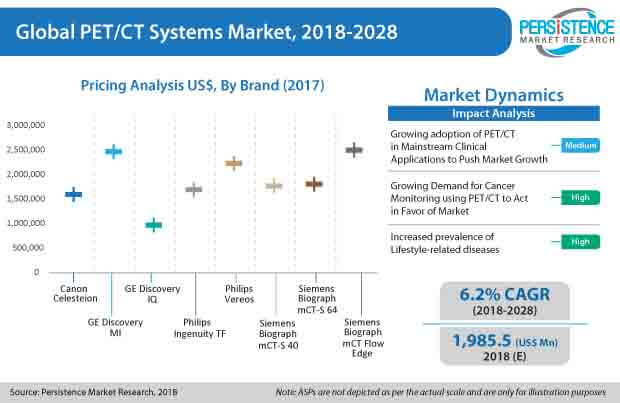The Pet CT Systems Market is bound to grow at a remarkable rate in the forecast period. Vital Sign monitoring, in combination with wearables, does aid in symptoms check-in as well as education 24/7. There are also hand-held dongles being made available for attaching to smartphones to measure biomarkers for chronic ailments. This monitoring proves to be more cost-effective and convenient in comparison with in-person care. This trend would be prevalent in the healthcare vertical going forward.
PET/CT systems are expected to continue to incorporate the highest clinical performance of PET as well as CT, and further evolve in parallel with these modalities for a long period. Constant developments in the radiopharmaceuticals used by PET/CT systems and increased government support for the research and development of these radiopharmaceuticals for medical imaging is expected to propel the PET/CT systems market during the forecast period.
According to the latest research by PMR, the global PET/CT systems market is expected to account for more than 3.0 billion US$ in terms of value, by the end of 2028. The PET/CT systems report also projects a significant growth potential, with an average Y-O-Y growth rate pegged at 6.2% through 2028.
To remain ‘ahead’ of your competitors, request for a sample @ https://www.persistencemarketresearch.com/samples/27460
PET/CT Systems Market: Dynamics
High capital investments are expected to be recovered by increased medical efficacy and patient throughput, leading to a decrease in the effective cost per image. According to various research studies, excluding additional costs, the usage of PET/CT systems is cost-efficient as these systems help avoid additional invasive procedures or imaging examinations. According to the president of Clinical Radiologists, Springfield, a new PET/CT systems costs around US$ 2 Million and a high-end CT system costs around US$ 1 Million. It costs around US$ 600,000 – US$ 700,000 less to buy Biograph mCT, as compared to purchasing 2 different high-end systems. Moreover, the device can be stored in a single room.
Furthermore, PET is quite a lengthy procedure that requires transmission as well as emission scans. The fusion image by PET/CT systems was projected to result in time saving for almost about 20-30 minutes per patient, which led to a 40% increase in patient output. According to a research study published by National Center for Biotechnology Information, the U.S., the metastases found in 16% of cancer patients, which was initially deemed resectable, led to cost savings amounting to US$ 1,066 per patient with the usage of PET/CT systems.
However, the short shelf-life associated with the radiopharmaceuticals used by PET/CT systems are expected to hinder the market growth for PET/CT systems. Radioactive isotopes possess their own disintegration pattern, which depends upon energy, matter, and rate of characteristic. A shorter half-life elevates higher radiation within a short span, which is a major disadvantage for the transportation of radioisotopes.
For instance, a major challenge in the usage of FDG is the extremely short half-life of 18F, which equals to approximately 2 hours. In practice, it indicates that every 2 hours of the travel time between the cyclotrons that is responsible for producing the fluorodeoxyglucose to the PET-CT systems replicate double the costs of FDG, which are the only largest variable costs incurred by any PET-CT systems business.
Get a Customized Scope to Match Your Need Ask an Expert- sales@persistencemarketresearch.com

Company Profiles:
- Siemens AG
- Overview
- Key Financials
- SWOT Analysis
- Key Developments
- Marketing Strategy
- General Electric Company
- Koninklijke Philips N.V.
- Hitachi, Ltd.
- Canon Inc.
- Neusoft Corporation
- MinFound Medical Systems Co., Ltd
PET/CT Systems Market: Segmentation
PMR has segmented the global PET/CT systems market based on the product type, isotopes, modality, applications, end use and region. The PET/CT systems market by product type is segmented into low-range slice PET/CT systems (>20), middle range-slice PET/CT systems (21-64), high-range slice PET/CT systems (<64). By isotopes, the market for PET/CT systems is segmented into Flurodeoxyglucose, 18 F Sodium Fluoride, 62 Cu ATSM, FMISO, Thallium, Gallium, and others.
By modality, the PET/CT systems market is segmented into fixed PET/CT systems and mobile PET/CT systems. By application, the PET/CT systems market is segmented into oncology, cardiology, neurology, and others. By end use, the PET/CT systems market is segmented into hospitals, diagnostic centers, cancer research centers, and specialty clinics. The PET/CT systems market has been analyzed across all the regions of North America, Latin America, Europe, South Asia, East Asia, Oceania, and the Middle East & Africa.
For in-depth competitive analysis, buy now @ https://www.persistencemarketresearch.com/checkout/27460
About us: Persistence Market Research
Contact us:
Persistence Market Research
Address – 305 Broadway, 7th Floor, New York City,
NY 10007 United States
U.S. Ph. – +1-646-568-7751
USA-Canada Toll-free – +1 800-961-0353
Sales – sales@persistencemarketresearch.com